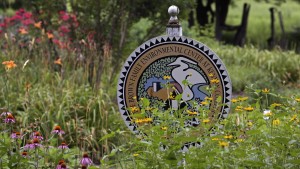It’s almost unbelievable to me that the prairie that we control-burned just over a month ago is already teeming with signs of new life. I can see from my window that tall grasses are already dominating the hillside. It won’t be long before it becomes a vibrant summer prairie brimming with wildflowers, buzzing insects, and wildlife galore.
I was told that we burn the prairie in order to preserve it — to keep it, as best as we can, a stable and healthy ecosystem. To me, that seemed counterintuitive. How can fire, something that destroys, be used to preserve?
To answer that question, we have to first explore what else might change ecosystems in the first place. Naturally, ecosystems change over time — just as we move through different stages of life (from college student to graduate, for a relevant example). This natural progression is a process called ecological succession.
There are two types of succession: primary and secondary. Primary succession hasn’t taken place at the BFEC for a very long time — primary succession is how an ecosystem first establishes itself. When exposed rock or barren land is left behind as the result of a natural disturbance (such as a glacier retreating or lava flowing), primary succession begins when “pioneer” species move in: mosses, lichens, and other brave species that can thrive without soil.
Over time, this primary succession can lead to land rich with nutrients as the pioneer species decompose into dirt. This process takes a long time, but it sets the stage for the next step: secondary succession.
Secondary succession is similar in that it begins with some kind of disturbance; however, it takes place where soil and nutrients are already established. When the ecosystem is “reset” by disturbances — storms or forest fires, for example — the process begins anew. Instead of mosses and lichens, the pioneer species of secondary succession include plants with deep roots that create an ecosystem of intermediate species like grasses and shrubs.
If left undisturbed, the ecosystem will proceed to the next and final step: the formation of what some ecologists call a climax community. These ecologists assert that this is the point where ecosystems “balance out” and remain relatively stable over time. As grasses and shrubs give way to larger, woody plants, grassy areas will slowly become forests, dominated by older, larger trees like oaks and hickories (in Ohio) that can become established in shady areas.
With this in mind, let’s revisit our prairie. What would happen if we left it alone, letting nature take its course? The grasses and shrubs would give way over time, slowly, to woody plants. Trees like those around the property would begin to take root, spreading their branches out over the wildflowers until there is too much shade for the flowers to grow. Our beautiful prairie — a habitat and home to many native animals — would become a forest.
Instead, when we burn the prairie, we create a disturbance — we reset the cycle. Burning the grass helps dying plants from the previous year break down, filling the role that grazing bison once did on prairies across the country. Through the process of clearing away the older grasses (and any trees that may have tried to move in), we leave the perfect environment for secondary succession to begin again.
Next year, as I watch the annual prairie burn, I will be figuring out what my next step will be. The new post-baccalaureate fellow will be stepping into my shoes, and then it will be their turn to watch the prairie burn. In a way, we’ve formed our own cycle of succession — each new post-bacc bringing new ideas and life to the role.
As I look forward to the year ahead, I am mindful of how much change one year can bring — ecologically and otherwise. What better reason do you need to live in the moment? In a place like central Ohio and on a preserve like the BFEC, I don’t want to miss a single second.
SUPPORT THE BFEC
MORE ABOUT KENYON'S GREEN INITIATIVES
